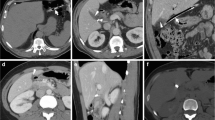Abstract
Purpose
To determine the diagnostic accuracy and time savings of an abbreviated magnetic resonance cholangiopancreatography (A-MRCP) protocol for detecting choledocholithiasis in patients visiting the emergency department (ED) for suspected biliary obstruction.
Methods and materials
This retrospective study evaluated adult patients (ages 18+ years) visiting an academic Level 1 trauma center between January 1, 2016, and December 31, 2017, who were imaged with MRCP for suspected biliary obstruction. Patients were scanned with either a four-sequence A-MRCP protocol or a conventional eight-sequence MRCP (C-MRCP) protocol. Image acquisition and MRI room time were compared. The radiology report was used to determine whether a study was limited by motion or prematurely aborted, as well as for the presence of pertinent biliary findings. Diagnostic accuracy of A-MRCP studies were compared with any available endoscopic retrograde cholangiopancreatography (ERCP) report within 30 days.
Results
One hundred sixteen patients met inclusion criteria; 85 were scanned with the A-MRCP protocol (45.9% male, mean 57.4 years) and 31 with the C-MRCP protocol (38.7% male, mean 58.3 years). Mean image acquisition time and MRI room time for the A-MRCP protocol were significantly lower compared to those for the C-MRCP protocol (16 and 34 min vs. 42 and 61 min, both p < 0.0001). Choledocholithiasis was seen in 23.5% of A-MRCP cases and 19.4% of C-MRCP cases. Non-biliary findings were common in both cohorts, comprising 56.5% of A-MRCP cases and 41.9% of C-MRCP cases. 44.7% of A-MRCP patients received subsequent (diagnostic or therapeutic) ERCP (mean follow-up time 3 days), in which A-MRCP accurately identified choledocholithiasis in 86.8% of cases, with sensitivity of 85%, specificity of 88.9%, positive predictive value (PPV) of 89.5%, and negative predictive value (NPV) of 84.2%. In comparison, 38.7% of C-MRCP patients underwent ERCP (mean follow-up of 2.3 days) with an accuracy of 91.7%, sensitivity of 80%, specificity of 100%, PPV of 100%, and NPV of 87.5%. Only 4.7% of A-MRCP exams demonstrated motion artifact vs. 12.9% of C-MRCP exams. One study was prematurely aborted due to patient discomfort in the A-MRCP cohort while no studies were terminated in the C-MRCP cohort.
Conclusion
An abbreviated MRCP protocol to evaluate for choledocholithiasis provides significant time savings and reduced motion artifact over the conventional MRCP protocol while providing similar diagnostic accuracy.


Similar content being viewed by others
References
ASGE Standards of Practice Committee (2010 Jan) Maple JT, Ben-Menachem T, Anderson MA, Appalaneni V, Banerjee S, et al. The role of endoscopy in the evaluation of suspected choledocholithiasis. Gastrointest Endosc 71(1):1–9
Yarmish GM, Smith MP, Rosen MP, Baker ME, Blake MA, Cash BD, Hindman NM, Kamel IR, Kaur H, Nelson RC, Piorkowski RJ (2014 Mar 1) ACR appropriateness criteria right upper quadrant pain. J Am Coll Radiol 11(3):316–322
Cronan JJ (1986 Oct) US diagnosis of choledocholithiasis: a reappraisal. Radiology. 161(1):133–134
Kang SK, Hoffman D, Ferket B, Kim MI, Braithwaite RS (2017 Aug) Risk-stratified versus non-risk-stratified diagnostic testing for management of suspected acute biliary obstruction: comparative effectiveness, costs, and the role of MR cholangiopancreatography. Radiology. 284(2):468–481
Verma D, Kapadia A, Eisen GM, Adler DG (2006 Aug 1) EUS vs MRCP for detection of choledocholithiasis. Gastrointest Endosc 64(2):248–254
Makmun D, Fauzi A, Shatri H (2017 Sep) Sensitivity and specificity of magnetic resonance cholangiopancreatography versus endoscopic ultrasonography against endoscopic retrograde cholangiopancreatography in diagnosing choledocholithiasis: the Indonesian experience. Clinical endoscopy 50(5):486–490
Kang SK, Heacock L, Doshi AM, Ream JR, Sun J, Babb JS (2017 Jun) Comparative performance of non-contrast MRI with HASTE versus contrast-enhanced MRI/3D-MRCP for possible choledocholithiasis in hospitalized patients. Abdominal radiology (New York) 42(6):1650–1658
Havsteen I, Ohlhues A, Madsen KH, Nybing JD, Christensen H, Christensen A (2017 May 30) Are movement artifacts in magnetic resonance imaging a real problem?—a narrative review. Front Neurol 8:232
Virzì V, Ognibene NM, Sciortino AS, Culmone G, Virzì G (2018 Oct 1) Routine MRCP in the management of patients with gallbladder stones awaiting cholecystectomy: a single-centre experience. Insights into imaging 9(5):653–659
Mills AM, Raja AS, Marin JR (2015 May) Optimizing diagnostic imaging in the emergency department. Acad Emerg Med 22(5):625–631
Kaltenthaler E, Vergel YB, Chilcott J, Thomas S, Blakeborough T, Walters SJ, Bouchier H. A systematic review and economic evaluation of magnetic resonance cholangiopancreatography compared with diagnostic endoscopic retrograde cholangiopancreatography, https://doi.org/10.1007/s41669-016-0001-4
Zaitsev M, Maclaren J, Herbst M (2015 Oct) Motion artifacts in MRI: a complex problem with many partial solutions. J Magn Reson Imaging 42(4):887–901
Author information
Authors and Affiliations
Corresponding author
Ethics declarations
Conflict of interest
The authors declare that they have no conflict of interest.
Additional information
Publisher’s note
Springer Nature remains neutral with regard to jurisdictional claims in published maps and institutional affiliations.
Rights and permissions
About this article
Cite this article
Tso, D.K., Almeida, R.R., Prabhakar, A.M. et al. Accuracy and timeliness of an abbreviated emergency department MRCP protocol for choledocholithiasis. Emerg Radiol 26, 427–432 (2019). https://doi.org/10.1007/s10140-019-01689-w
Received:
Accepted:
Published:
Issue Date:
DOI: https://doi.org/10.1007/s10140-019-01689-w




